#decomposition
Explore tagged Tumblr posts
Text

#roadkill squirrel#the beloved#on my walk#mine#photography#my photo#nature photography#animal photography#squirrel#rural gothic#southern#original photographers#southern americana#rural photography#southern gothic#south east#photographers on tumblr#animal#animals#dead animal#roadkill#nature#decomposition
23 notes
·
View notes
Text
Writing Notes: Stages of Decomposition

The decomposition process occurs in several stages following death:
Pallor mortis
Algor mortis
Rigor mortis
Cadaveric spasm
Lividity
Putrefaction
Decomposition
Skeletonization
PALLOR MORTIS
The first stage of death.
Occurs once blood stops circulating in the body.
The cessation of an oxygenated blood flow to the capillaries beneath the skin causes the deceased to pale in appearance.
In non-Caucasians, the pallor may appear to develop an unusual hue; the skin will lose any natural lustre and appears more waxen.
Occurs quite quickly, within about 10 minutes after death.
ALGOR MORTIS
The cooling of the body after death.
The cooling process will be influenced by many factors, including the deceased’s clothing, or whether they are covered with bed linen such as blankets or duvets.
The body will typically cool to the ambient room temperature, but this alters if there is heating in the room or if there is a constant draught cooling the body.
RIGOR MORTIS
Can occur between 2 and 6 hours after death.
Factors including temperature can greatly affect this.
Caused by the muscles partially contracting, and the lack of aerobic respiration means that the muscles cannot relax from the contraction, leaving them tense, subsequently resulting in the stiffening we associate with rigor mortis.
This stage typically begins in the head, starting with the eyes, mouth, jaw and neck, and progresses right through the body.
The process is concluded approximately 12 hours after death (although, again, certain variables may occur) and lasts between 24 and 72 hours depending on circumstances.
Contrary to popular belief, rigor mortis is not a permanent state and is in fact reversed, with the muscles relaxing in the same order in which they initially stiffened.
The reversing process also takes approximately 12 hours, when the body returns to its un-contracted state.
It is possible to ‘break’ rigor mortis by manipulating and flexing the limbs. This is usually done by undertakers, pathologists or crime scene investigators who are attempting to examine or move a body – or by a murderer trying to hide their victim in the closet or the boot of a car.
CADAVERIC SPASM
A phenomenon that can be misinterpreted as rigor mortis.
The instantaneous stiffening of the body (most commonly the hands) following a traumatic death.
Unlike rigor mortis, the stiffening of the affected limb is permanent and is not reversed, causing the deceased to maintain the rigidity until such time as putrefaction causes breakdown of the particular muscle group.
Examples:
The deceased following an air crash were later discovered still clutching their seatbelts or arm rests in a final, desperate act of survival.
In a drowning case, the victim was discovered with grass from the riverbank still grasped in their hand.
Perhaps the most famous case of cadaveric spasm involves the rock band Nirvana’s lead singer, Kurt Cobain. Cobain reportedly committed suicide in April 1994. His body was discovered a few days after his death with a shotgun wound to the head, and tests revealed he had large traces of heroin in his system. He was reportedly discovered still clutching the gun in his left hand, due to cadaveric spasm. However, a great deal of controversy surrounds the veracity of this latter assumption, and indeed the cause of his death, with many people insisting and attempting to prove that he died as the result of foul play rather than suicide.
LIVIDITY
Also known as livor mortis, hypostasis, or suggillation.
Once blood can no longer circulate, it will gravitate towards the lowest point of the body.
Example: A supine body will display pinkish/purple patches of discoloration where the blood has settled in the back and along the thighs.
Occurs about 30 minutes after death, but will not necessarily be noticeable until at least 2 hours afterwards as the pooling process intensifies and becomes visible, finally peaking up to between 8 and 12 hours later.
Once it is complete, the lividity process cannot be reversed.
Therefore a body discovered lying on its side, but with staining evident in the back and shoulders, must have been moved at some point from what would have been a supine position at the time of death.
It is worth noting that if the body has had contact with the floor, a wall or other solid surface, lividity would not occur at the points of contact as the pressure would not allow the blood to seep through the capillaries and pool. The specific area of pressure will be the same colour as the rest of the body and a pattern of contact may well be evident.
PUTREFACTION
Derives from the Latin putrefacere, meaning ‘to make rotten’.
The body becomes rotten through the process known as autolysis, which is the liquefaction of bodily tissue and organs and the breakdown of proteins within the body due to the increased presence of bacteria.
The first visible sign is the discoloration of the skin in the area of the abdomen.
Bacteria released from the intestine cause the body to become bloated with a mixture of gases; over time these will leak out, and the smell will intensify to unbearable proportions.
Typically, this will attract flies that will lay eggs, which develop into maggots.
Bloating is most evident in the stomach area, genitals and face, which can become unrecognizable as the tongue and eyes are forced to protrude due to the pressure of the build-up of gases in the body.
At this stage, the body will also begin to lose hair.
The organs typically decompose in a particular order: starting with the stomach, followed by the intestines, heart, liver, brain, lungs, kidney, bladder and uterus/prostate.
Once all the gases have escaped the skin begins to turn black: this stage is called ‘black putrefaction’.
As with all the other stages of death so far, the rate of putrefaction depends on temperature and location. A body exposed to the air above ground will decompose more quickly than a body left in water or buried below ground.
During putrefaction, blistering of the skin and fermentation can also occur:
Fermentation - a type of mould that will grow on the surface of the body. This mould appears white, and is slimy or furry in texture. It also releases a very strong, unpleasant, cheesy smell.
As the putrefaction process comes to an end, fly and maggot activity will become less, which leads to the next stage.
DECOMPOSITION
The body is an organic substance comprising organisms that can be broken down by chemical decomposition.
If the body is outside, any remains that have not been scavenged or consumed by maggots will liquefy and seep into the surrounding soil.
Thus when the body decomposes it is effectively recycled and returned to nature.
SKELETONIZATION
The final stage of death is known as ‘dry decay’, when the cadaver has all but dried out: the soft tissue has all gone and only the skeleton remains.
If the cadaver is outside, not only is it exposed to the elements but it also becomes food for scavengers such as rats, crows or foxes.
As the remains are scavenged, the body parts become dispersed so it is not unusual to find skeletal remains some distance from where the body lay at the point of death.
The way in which skeletal remains are scattered in such cases is of interest to archaeologists, and is referred to as taphonomy.
Where a body has lain undiscovered at home for a period of time it has also been known for family pets, typically dogs, to feed on the body. The natural instinct of a pet is to attempt to arouse the deceased by licking them, but once it gets hungry, its survival instinct will take over and it will consider the body as little more than carrion: it will act with the same natural instinct as a scavenger in the wild, which will feed on any corpse, be it animal or human, if it is starving.
Obviously the number of pets, the body mass of the deceased and the time lapse before the body is discovered will influence to what extent it has been devoured.
For further research on the stages of decomposition and the factors that affect it, look up body farms. These are medical facilities where bodies are donated for research purposes so scientists can specifically observe the decomposition process. However, be aware that some of the images are quite graphic.
Source ⚜ More: References ⚜ Autopsy ⚜ Pain & Violence ⚜ Injuries Bereavement ⚜ Death & Sacrifice ⚜ Cheating Death ⚜ Death Conceptions
Writing Resources PDFs
#writing reference#decomposition#writeblr#spilled ink#dark academia#writing notes#fiction#creative writing#novel#light academia#literature#writers on tumblr#léon cogniet#poets on tumblr#writing prompt#poetry#writing prompts#writing tips#crime fiction#writing resources
4K notes
·
View notes
Text
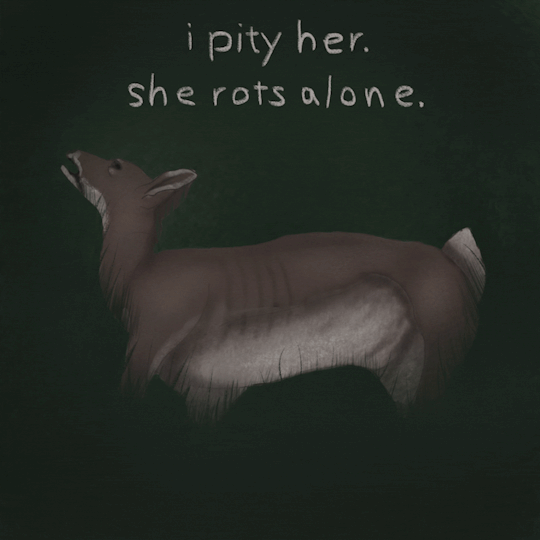
there is a doe in my backyard.
i walk out onto my porch and get hit with a wave of sickly sweetness,
it's clearly been a few days since her passing, and the maggots already have claimed her as their next project
the skin around her bones has become sunken, her ribs very visible in the sunlight
her once soft fur sloughs off her skin onto the soil around her, the greenery beneath her turning a dark brown
she is no longer beautiful, but instead a mass of dark flesh festering with insects and bacteria
i pity her. she rots alone.
25 notes
·
View notes
Photo


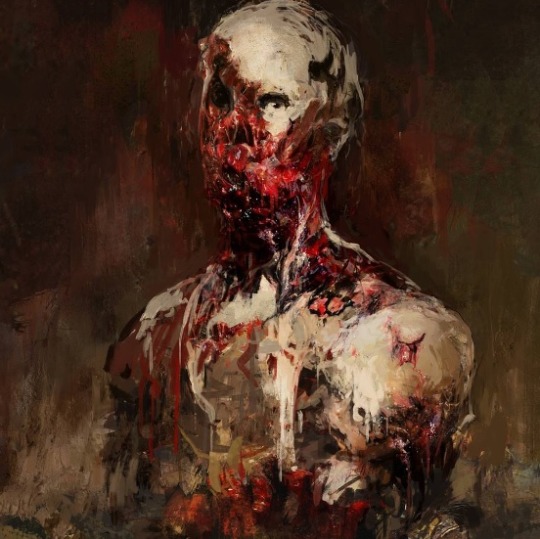

𝔏𝔞𝔶𝔢𝔯𝔰 𝔬𝔣 𝔉𝔢𝔞𝔯 𝔭𝔬𝔯𝔱𝔯𝔞𝔦𝔱𝔰 𝔬𝔣 𝔚𝔦𝔣𝔢 𝔟𝔶 𝔄𝔫𝔡𝔯𝔷𝔢𝔧 𝔇𝔶𝔟𝔬𝔴𝔰𝔨𝔦
#Andrzej Dybowski#painting#artwork#transformation#zombie#rotten#decomposition#blerghhhh!!!#Illustration#art#illustrations#rotting
1K notes
·
View notes
Text
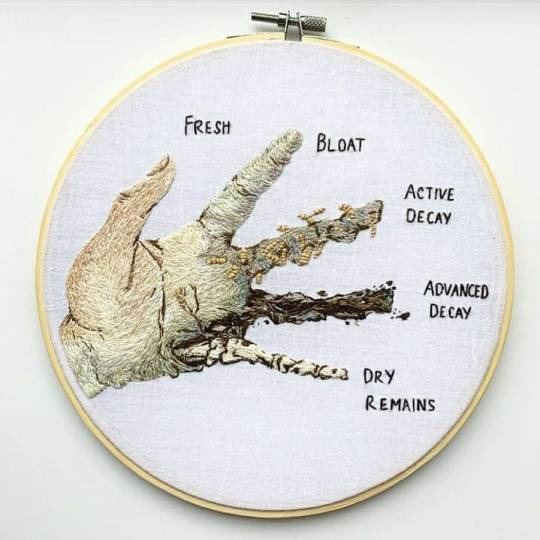
Stages of Decomposition Embroidery by @calicoranger
#beauty in darkness#dark beauty#goth#dark art#gothic#grunge#dark#art#dark aesthetic#decomposition#rot#skeletons#im a creep im a weirdo#darkcore#darkness#dark artist#dark fantasy#skull#dark grunge#darkart#eerie#spooky#keep it creepy
2K notes
·
View notes
Text

193 notes
·
View notes
Text



"Vultures are holy creatures."
Inspired by a poem by Jarod K. Anderson AKA the CryptoNaturalist. God bless, I can't wait one day to decompose <3 @cryptonature
#vulture culture#traditional art#emerald city comic con#turkey vulture#vulture core#california condor#eccc 2025#eccc#illustration#animal art#animal illustration#animal artist#mushrooms#fungi#coyote skull#mushroom#coyote#bird art#vultures#decomposition#decomposers#i want to decompose#the cryptonaturalist
309 notes
·
View notes
Text



#coquette#morute#creepy cute#horror#creepy aesthetic#creepycore#dollette#animals#taxidermy#artwork#art#decomposition#morbid cute#morbidette
142 notes
·
View notes
Text
Getting back into fnaf, i think this is my 5th hyperfixation on it over my whole life
Anyway i made michael timeline drawings,,, if a couple people want it ill post the full timeline(its 4k words)

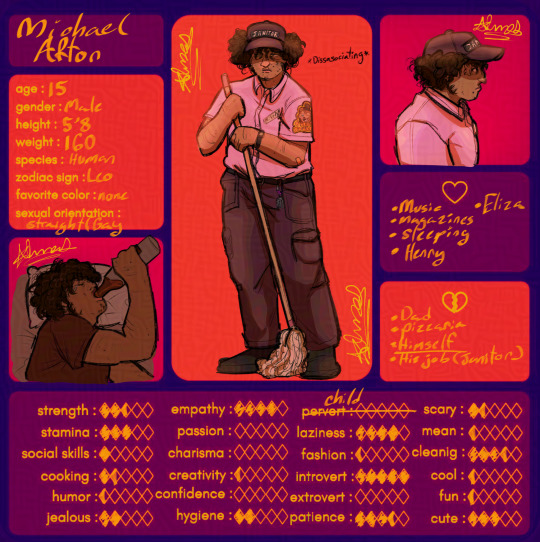

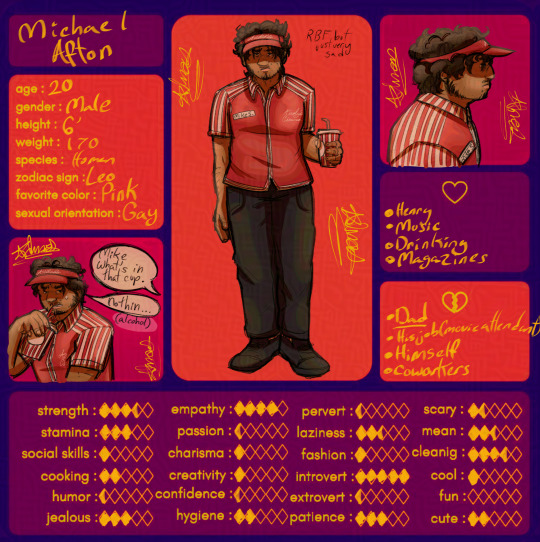

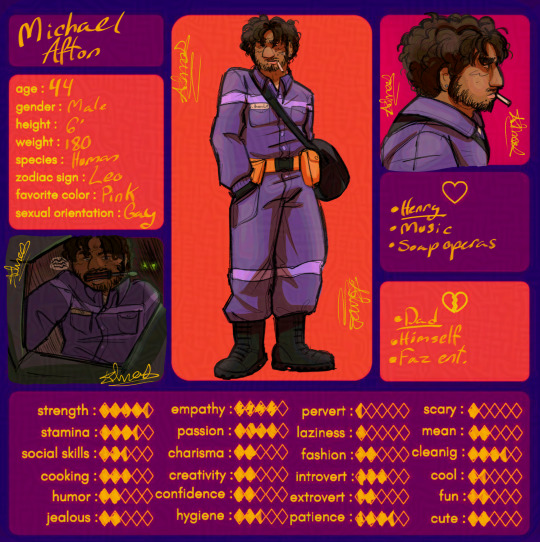
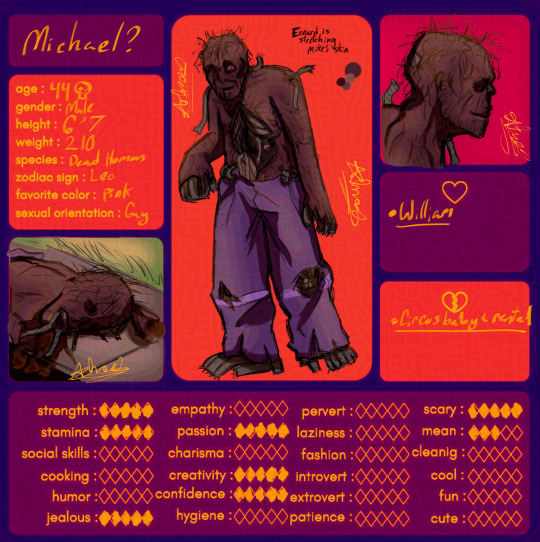
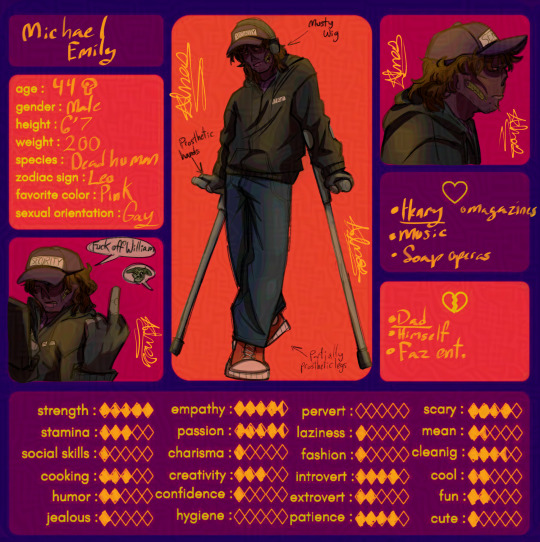

#fnaf#fnaf fanart#fnaf fandom#fnaf au#michael afton#mike afton#afton family#five nights at freddy's#five nights at freddys#fivenightsatfreddysfanart#fnaf redesign#redesign#theres gotta be more tags#just realized i forgot the gore tags#cw: gore#blood and gore#decomposition#zombie#cw blood#tw blood#tw g0r3#cw g0re#tw g0re#tw bl0od#cw bl00d#cw bl0od
198 notes
·
View notes
Text
Writing Notes: Some Causes of Death
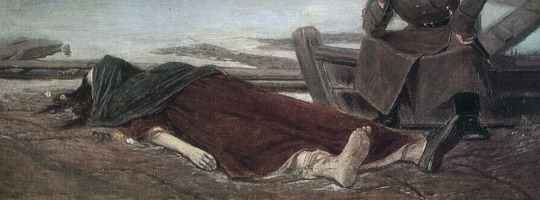
There are certain causes of death, or conditions that prevail during the decomposition process, that may cause the body to take on an unusual appearance or to deviate from the expected state of decomposition. These can include:
Drowning
Fire (charring)
Mummification
Carbon monoxide poisoning
DROWNING
Can be accidental, murder, or suicide.
Dumping a body in water may be a murderer’s attempt to dispose of it in the hope that it will remain undiscovered or to degrade any tell-tale DNA or trace evidence.
It is possible for the pathologist to ascertain if death has been caused by drowning or if the person was already dead before entering the water.
The presence of diatoms in the body indicates that death was caused by drowning.
Diatoms - a type of single-celled algae unique to the body of water they are found in; this may be saltwater or freshwater, and from a specific lake or estuary.
They are not present in tap water as it is filtered, and therefore will not be present in somebody who has drowned in a bath, although water present in the stomach and lungs of the deceased is still indicative of death by drowning.
Diatoms can only enter the body by being ingested through the lungs or stomach of a living person while the heart is still beating. Their presence will then be discovered in the blood, bone marrow and brain of the deceased.
When attending water deaths, a water sample will be taken so the diatoms present in the source can be compared to those identified in the body.
In this way, investigators can ascertain whether the victim was drowned in the same body of water in which it was discovered.
Bodies that have been immersed in water for any length of time are likely to be discovered in a macerated form.
This is when the skin wrinkles and loosens to such an extent that it starts to become detached.
The skin may also appear adipocerous: this is when a wax-like coating progressively covers the body when it is overexposed to wet conditions.
Adipocere - caused by the reaction of body fat to water; hydrolysis occurs, resulting in the coagulation of fat, which spreads across the surface of exposed areas of the body.
Vagal drowning occurs when the vagus nerves become unintentionally over-stimulated, resulting in a cardiac arrest.
The vagus nerves serve the lungs, heart, chest and abdomen.
Cardiac arrest can occur when the body is suddenly exposed to cold water, which causes vagal inhibition, particularly when cold water suddenly enters the larynx or ears, or strikes the abdomen in the event of the person falling into water.
This instantaneous reaction leaves a person incapacitated, and is potentially the cause of many deaths of people who are under the influence of drink or drugs and behave without due care and attention when close to canals and waterways.
Inhibition of the vagal nerve can also occur during asphyxiation.
FIRE
This process can be an opportunity for murderers to dispose of cumbersome corpses before they succumb to the unpleasantness of decomposition.
Pathologists will be able to ascertain if the victim was dead before the fire by examining the lungs and airways to detect the presence of soot.
Even if the body is severely blackened through charring, it can still provide pathologists with much needed clues.
If a body has been assaulted prior to the fire, it is possible for pathologists to detect signs of an assault by examining the skeletal remains.
Another indication that a person has been assaulted prior to the fire is the lack of what is called ‘pugilistic pose’ in the body.
This is taken from a boxing stance where the fighter stands with clenched fists and arms, and legs flexed in a particular defensive position.
During a fire, the intense heat causes the hands, elbows and knees to flex and stiffen, drawing the body into this recognized position.
If, however, the victim was assaulted before the fire, then damage to the joints will prevent the body adopting the pugilist position.
MUMMIFICATION
A body may not decompose depending on certain circumstances.
Example: Bodies kept in extremely cold conditions will not succumb to bacteria or insect activity.
The Lindow Man is one of many preserved bodies recovered from peat bogs across the United Kingdom: his remains were discovered by peat cutters working on Lindow Moss, Cheshire in 1984. Experts have concluded that he died a violent death between 2 BC and 119AD and his body has been preserved for the ensuing centuries due to the cool temperature, low oxygenation and high acidity of the peat bog.
Following death, some bodies may not succumb to the decomposition process because they become mummified.
In order for this state to occur, the body must be exposed to a stable temperature (preferably warm) with a steady air current, which allows the body to dry out.
The desert is an ideal environment to promote mummification, but the right combination of elements nearer to home has also produced the same effect.
Example: In Germany in 1994, police discovered the mummified remains of a lady who they believe had died of natural causes 6 months earlier. She was discovered in her lounge in front of the television, and neighbours only thought to raise the alarm after noticing that her letterbox was overflowing with post. The lady’s body was most likely mummified due to the constant temperature of her room over such a long period of time.
CARBON MONOXIDE POISONING
The introduction of unleaded petrol and catalytic converters in cars has led to a decline in the typical suicide scenario of a desperate person sitting in their car with the engine running and a hosepipe threaded through the window.
Even so, carbon monoxide is still very much a killer due to faulty gas pipes and damaged heaters and fires.
The early symptoms of carbon monoxide poisoning can be similar to flu, but increased exposure to the gas, as well as old age and failing health, can prove fatal to the victim. One of the noticeable, distinct features of a person who has died as a result of carbon monoxide poisoning is cherry reddening of the skin.
In normal circumstances in the first stage of death, there is a noticeable paling of the skin due to algor mortis, therefore this distinctive reddening is an obvious sign that death has not occurred due to natural causes.
Source ⚜ More: References ⚜ Autopsy ⚜ Pain & Violence ⚜ Drowning Mummification & Cheating Death ⚜ Carbon Monoxide Poisoning
#writing reference#decomposition#writeblr#spilled ink#dark academia#writing notes#fiction#creative writing#novel#light academia#literature#writers on tumblr#léon cogniet#poets on tumblr#writing prompt#poetry#writing prompts#writing tips#crime fiction#vasily perov#writing resources
170 notes
·
View notes
Text


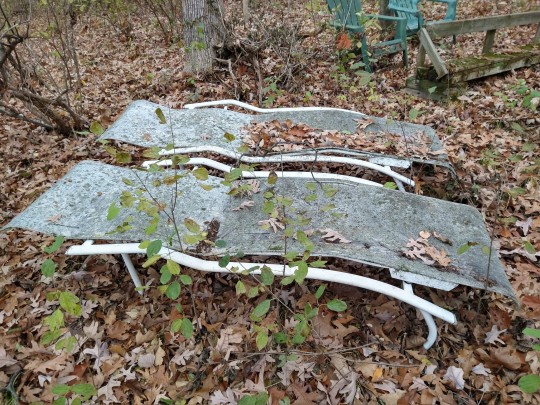
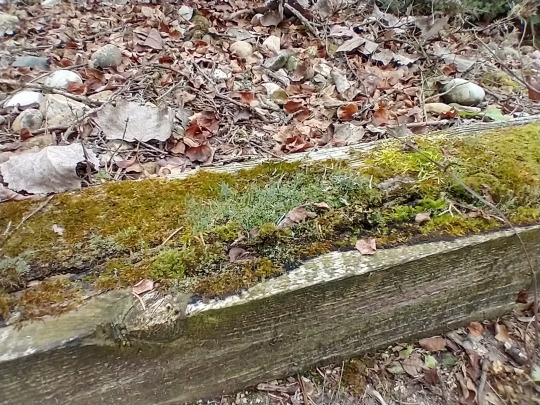
Have you ever gone somewhere that you shouldn't be admiring the decay but you do because you love lichens and really decomposition as a whole
262 notes
·
View notes
Text
Stages of Decomposition #2
Second Stage: Bloating
Once autolysis has occurred, the bacteria within the body begin to produce various gases, these include gases such as ammonia, methane, carbon dioxide, etc. which result in the body bloating - during this time the body can temporarily double in size.
At this stage of the process, putrefaction will begin being produced, as well as the discolouration of skin and the presence of specific insects that have been drawn to the corpse by the odours being released.
The insects present on a corpse allow for the Post-Mortem Interval (PMI), also known as the time of death, to be determined via the study of forensic entomology. Certain species of insects will only be present upon a corpse within certain stages of the decomposition process. The species, as well as how many generations of these insects exist within the orifices of the body, allow for us to discover how long a body has been deceased.
#actually mentally ill#decomposing#decomposition#stages of decay#forensic entomology#post mortem#actually autism#special interest
45 notes
·
View notes
Text

A (somewhat) accurate process of Mike rotting after he got scooped because I'm literally obsessed with the stages of decomposition and I've been curious about it since seeing that cutscene in SL.
disclaimer!!! I did not use gore photos or non-con photos of the deceased, my references were pigs or medical literature
Close-ups below + decomp timeline:

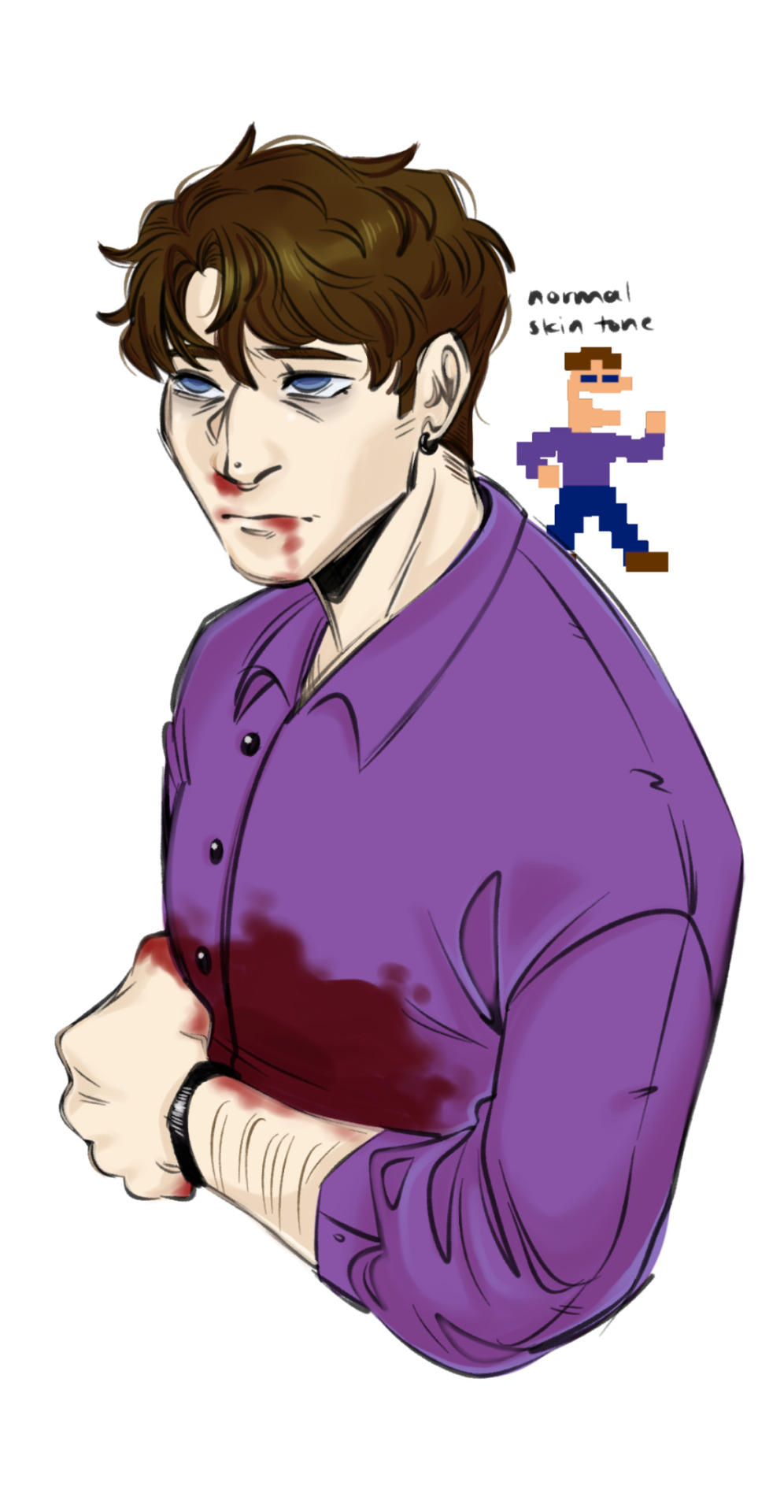
Stage 1 - Immediately after to a couple hours since death, Pallor Mortis (paling of skin) and Algor Mortis (gradual loss of body heat) occurs. Livor Mortis (pooling of blood to extremities) begins to set in.

Stage 2 - A couple hours to a couple days after Michael's death, Livor Mortis has become fixed, giving the lowest extremities on his body (hands, feet) a purplish hue. Rigor Mortis (stiffening of muscles) occurs and fades after a few days. Autolysis (destruction of cells by the self) causes loosening of skin, fluids released gives it a sheen. Eyes start to cloud.
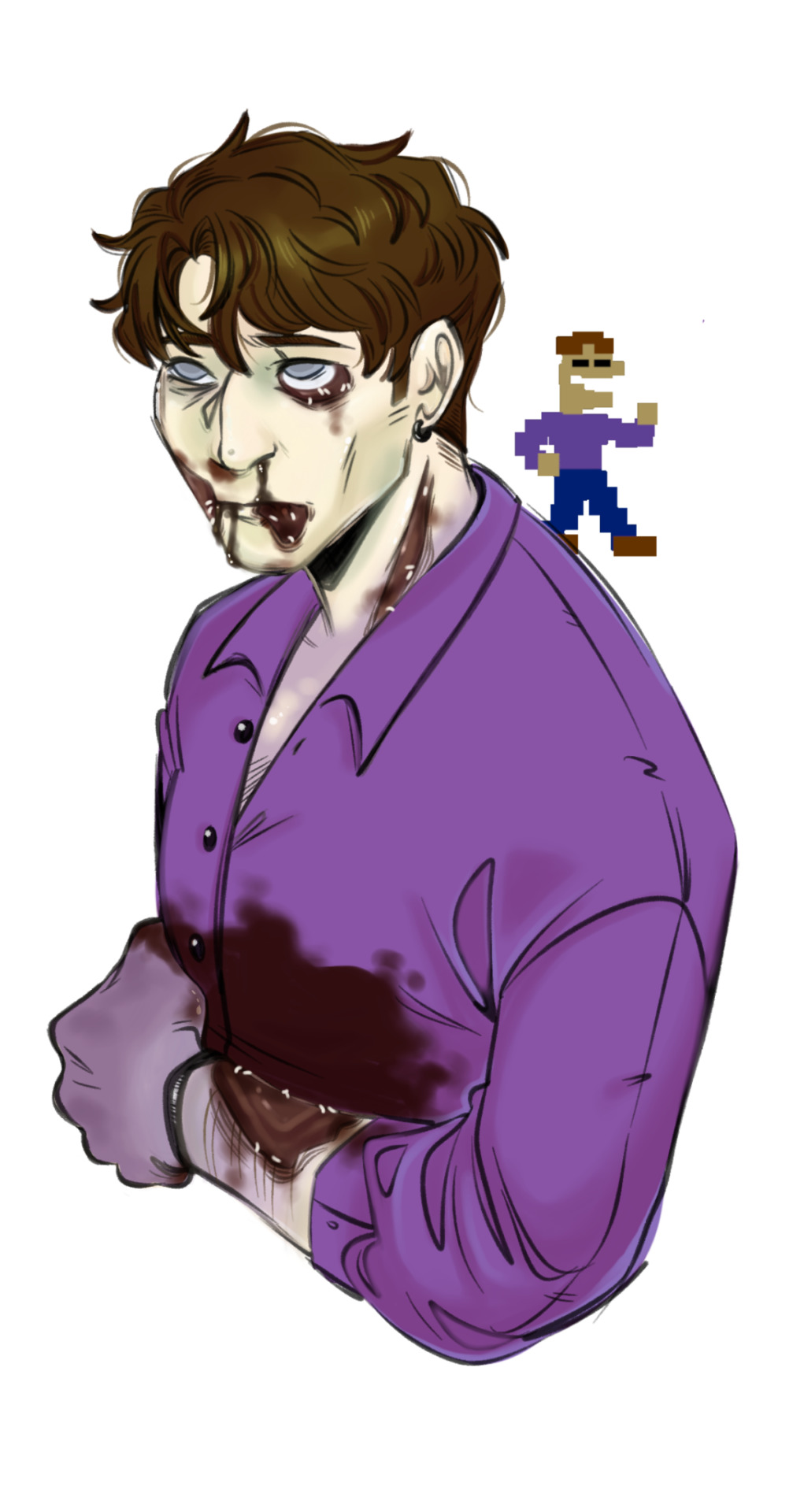
Stage 3 - A couple days to almost a week since his death. He should be bloating like a balloon but the giant fucking hole in his stomach from the scooper releases all gases (he stinks.) Ennard puppeting his body made it hard for flies to land but they eventually got there and the maggots have hatched. Continued decay of his flesh turns him greenish and makes his skin slough off. Liquefied meat seeps from his orifices. Eyes are fully clouded.
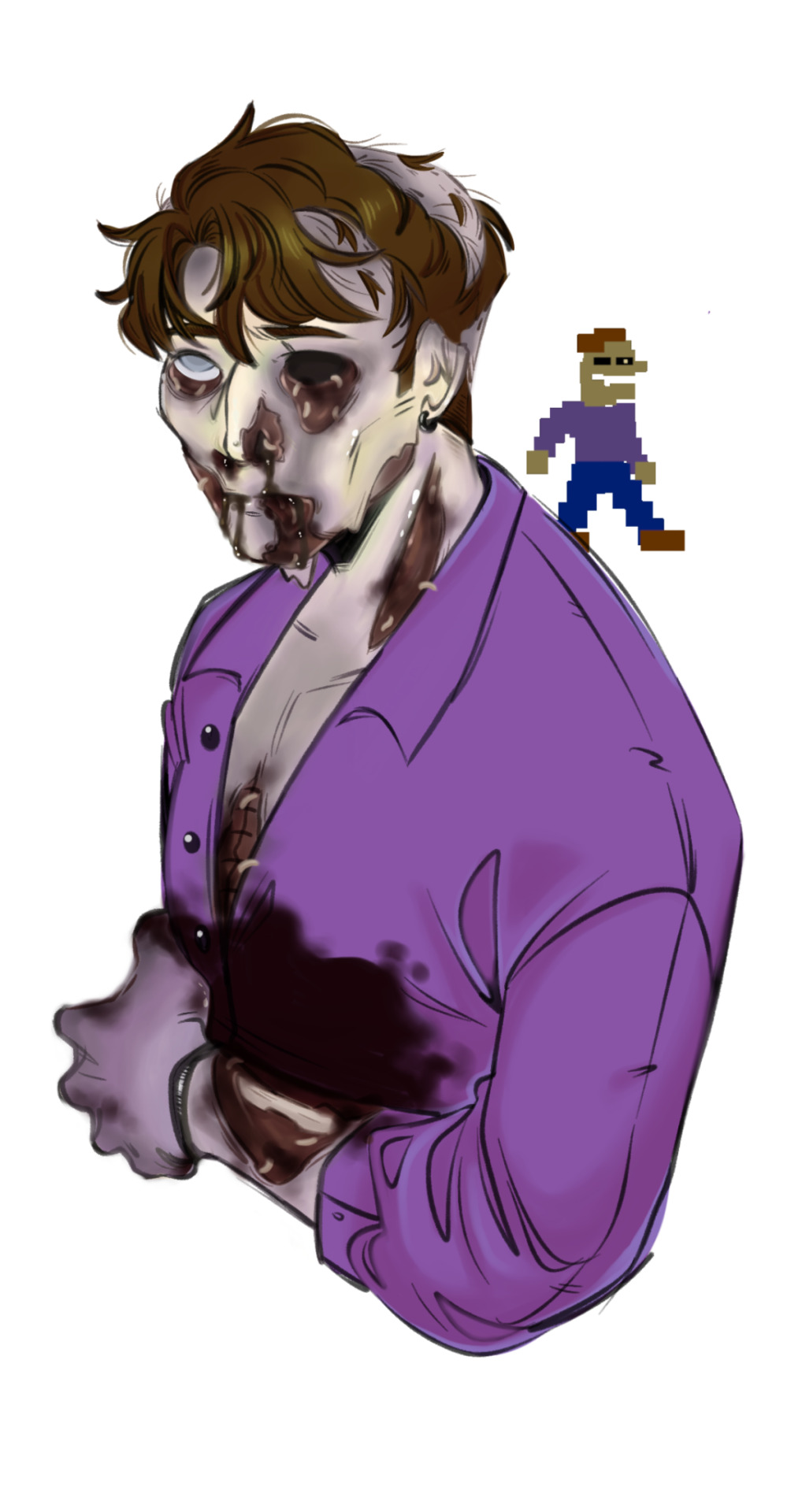
Stage 4 - A week to a couple weeks since the scooper. Bro is experiencing premature male pattern baldness. He's all squishy and slimy from the body fluid and rotting. Exposed parts become a purplish-black colour and the maggots are graduating to further life stages. Eyeballs cave in, get eaten, or in Michael's case, pop out.
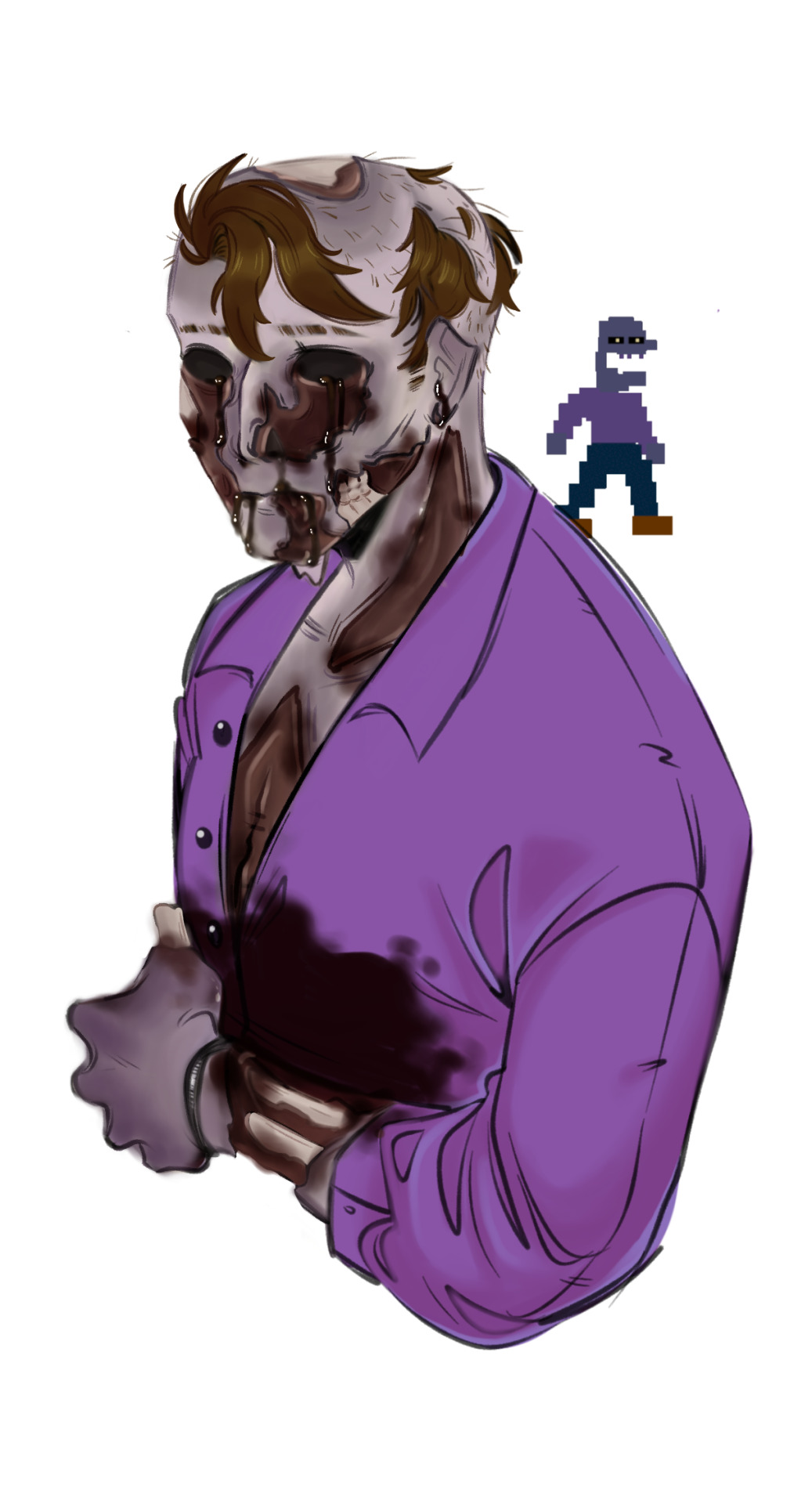
Stage 5 - A couple weeks to a month since bro's death. The last chunks of his hair are holding on by a miracle. Most of his outer flesh is eaten away and is almost entirely a purplish-black. Maggots have mostly turned into flies and left for college.
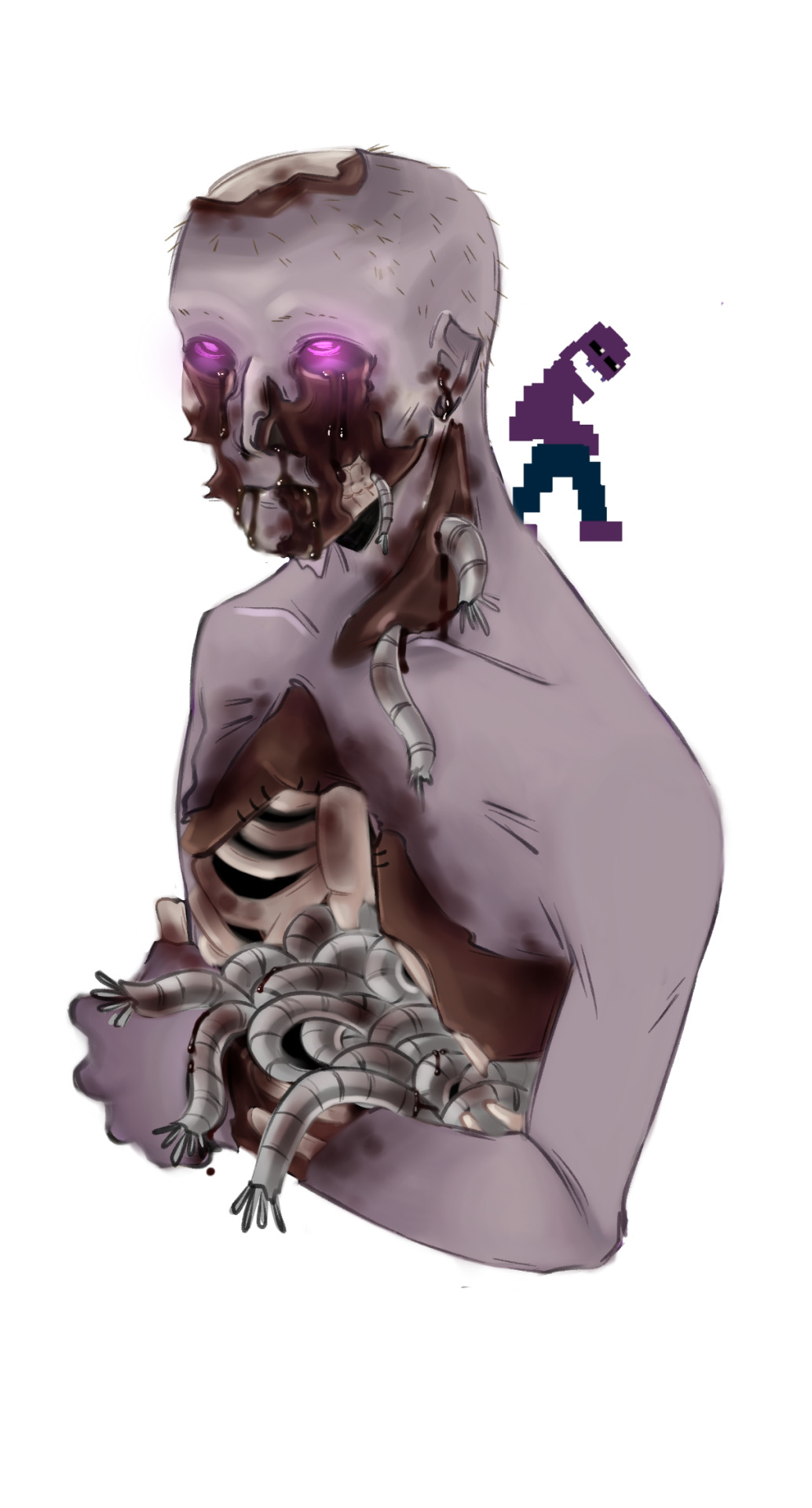
Stage 6 - Ennard realizes they can't stay in a zombie anymore and decides to dip. Leaves Michael a fresh set of eyes as a "sorry" gift. His rotting has thankfully stopped but it'll take a while for him to regenerate. Or not. I have no idea how remnant works. For now, he's basically a sack of rotted flesh and exposed bone. Bald.

This entire post is essentially-

#fnaf#michael fnaf#michael afton#fnaf sister location#ennard#decomposition#corpse#myart#decomposition is literally one of my favorite topics ever#what one semester of forensics classes does to a mf#next up in my strange interests: the psychological effects of cannibalism#tw blood#tw g0re#tw death
221 notes
·
View notes
Photo
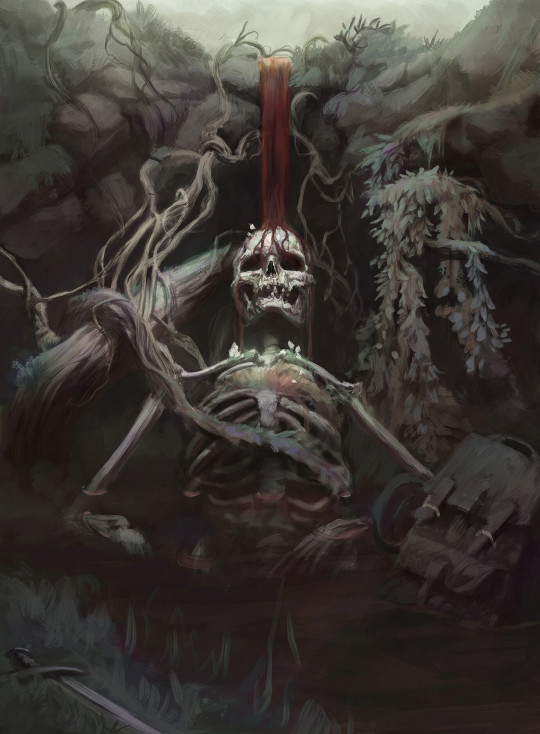
Back to the Roots - Shower by Alex Kuhn
1K notes
·
View notes
Text
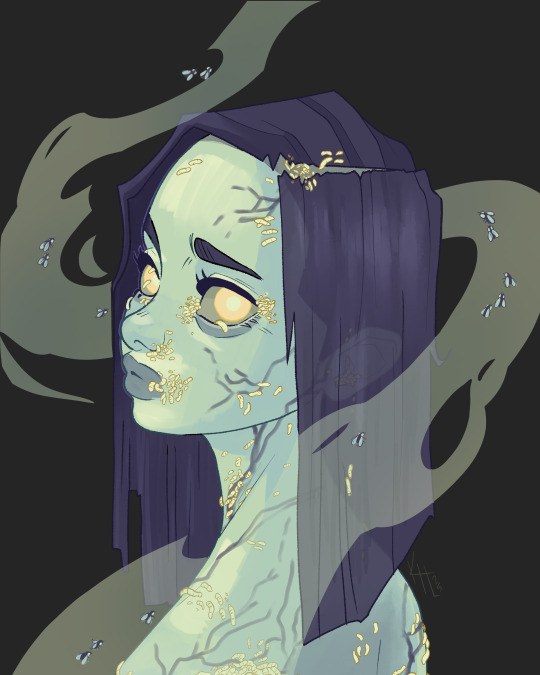
Slowly getting out of art block.
60 notes
·
View notes
Text
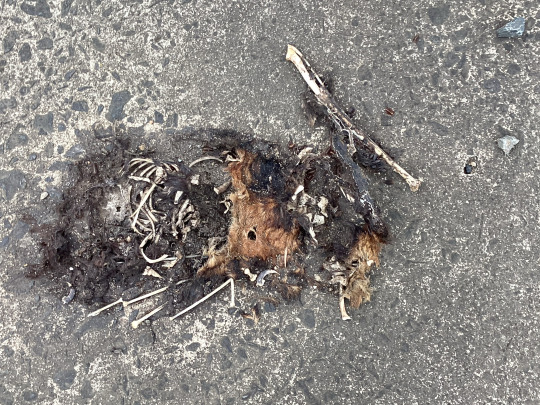
78 notes
·
View notes